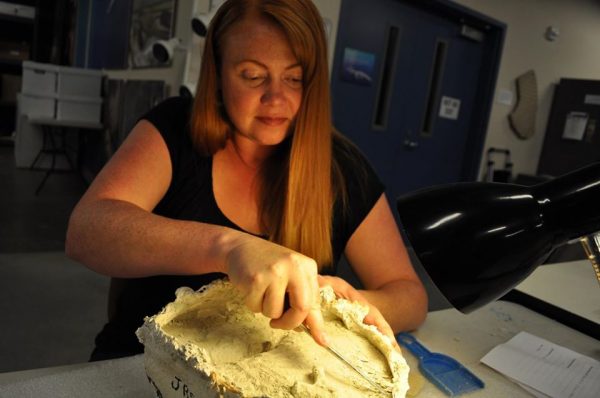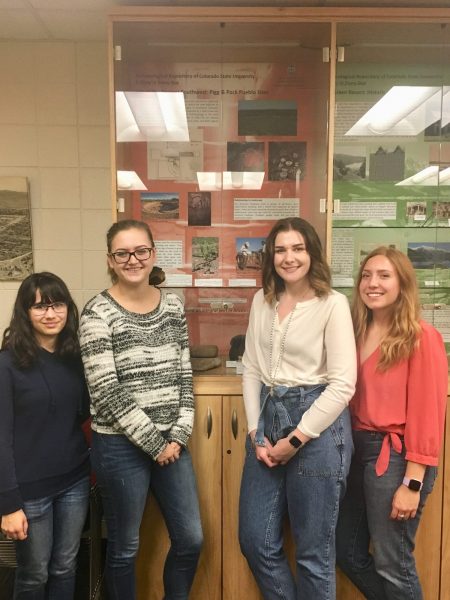New Undergraduate Museum and Cultural Heritage Studies Certificate Offers Education through Curation
Joshua Zaffos
As populations self-isolate and cities, states, and nations have mandated stay-at-home orders to slow the spread of the novel Coronavirus, one group of professionals is investigating what artifacts and images will best capture this moment in our collective history. Museum curators and collections managers, across Europe in particular, are working to observe and document the history of the COVID-19 pandemic as it happens. Even at Colorado State University, Archives and Special Collections has begun a COVID-19 Archive, and is soliciting and gathering stories and materials from students, faculty, staff, and community members. Photographs of quarantined families singing from apartment balconies, objects such as makeshift facemasks, interviews with healthcare workers, and even social-media posts will enable future generations to understand this unprecedented moment on earth, thanks to the efforts and know-how of curators, archivists, and other cultural-heritage specialists.
This type of “rapid response collection” is real-time archaeological research, and it’s among a set of applied and innovative skills that museum curators and cultural heritage managers look for among new and early-career staff. But actual experiences and skills are often hard to gain for archaeology and anthropology students who are curious about the fields of museum collections and cultural heritage.

“We know there’s significant interest – from both museums and students – to have museum classes that offer active learning and hands-on practice,” said Jeannine Pedersen-Guzman, Archaeological Collections Manager in the Department of Anthropology and Geography at Colorado State University.
Anthropology and Geography aims to fill that niche starting this fall, when the department will launch a new undergraduate certificate in Museum and Cultural Heritage Studies, developed by Pedersen-Guzman. The program will prepare students for jobs and careers in museums and education centers and at cultural heritage areas, including national parks and historic sites. The certificate is the first undergraduate certificate of its kind in the state of Colorado.
“The vast majority of museum jobs are in small or local museums, and they are looking for people with the education and – just as much – the experience,” said Pedersen-Guzman, who works with history and heritage museums across the state through the Colorado Curation Alliance, a network organized by History Colorado. “The certificate will give our students an edge.”
The program also fits well within the larger mission and culture of the Anthropology and Geography Department, said Mica Glantz, department chair and professor of biological anthropology. “We are attentive to how important it is for our scholarship to speak to the public and to have the public engaged with how we understand the human condition. This new certificate represents another avenue for us to bring our research questions and methods to life for students and the community.”
The 12-credit program includes courses that introduce students to the history of museums, cultural heritage management, artifact handling and collections management, curation methods, and ethics and current issues facing museums and cultural sites. Enrolled students also complete a practicum or internship at a museum, in the campus archaeological repository, or another site.

In Anthropology Curation and Exhibit Methods (ANTH 462), a course developed specifically for the certificate, students learn how to process, store and display artifacts and to design exhibits. The Fall 2019 class put techniques into practice and created four impressive exhibit cases for the Clark A026 classroom that display artifacts from historic and heritage sites around Colorado. Electives for the certificate include classes in anthropology and geography, art and art history, ethnic studies, and history. Coursework includes learning opportunities to explore rapid response and other collections efforts unfolding around the COVID-19 pandemic.
“Most people think of museums as preserving and presenting the past, but it is also the responsibility of museums to document the present,” said Pedersen-Guzman, who emphasizes many of the contemporary challenges faced by museums and heritage centers through her teaching. “Many museums will develop exhibitions about the pandemic in real-time and when they open their doors, these exhibitions will provide people and communities with content to reflect on, understand and heal. Students will gain a profound understanding of these concepts having lived through this historic event.” They may also find themselves tasked with choosing artifacts and curating content to best reflect the “shared human experience” of the pandemic.
“I’m a very visible and hands-on learner, so learning about curation, how to make a display, and just the vocabulary and taxonomies around collections was really useful and important for me,” said Kit Kelly, a senior Anthropology major, with a focus in archaeology, who took ANTH 462 last fall. From deciding on which artifacts and items to present to how to angle and position objects and display tags, “it’s a lot more technical than people realize.”
Kelly has also gained practical skills from internships and practicum opportunities that are a key component of the Museum Studies certificate. Kelly has interned at the Fort Collins Museum of Discovery, gaining valuable experience with grant writing. She has also worked in the CSU Archaeological Repository – housed in the basement of the Andrew G. Clark Building and which contains roughly 1,100 cubic feet of archaeological material and artifacts from more than 1,200 archaeological sites. There, Kelly has been curating artifacts from a former field site, cataloging and cross-referencing thousands of projectile points and other objects.
These skills and projects “will make me stand out,” Kelly said, as she contemplates job and research opportunities after graduation.
“Through this certificate, we want to give students experiences and mentoring on top of coursework, and to give them another career option and opportunity to explore,” added Pedersen-Guzman. “We know the demand is there.”